
The Guadiana River, is an international river defining a long stretch of the Portugal-Spain border, separating Extremadura and Andalusia (Spain) from Alentejo and Algarve (Portugal). The river's basin extends from the eastern portion of Extremadura to the southern provinces of the Algarve; the river and its tributaries flow from east to west, then south through Portugal to the border towns of Vila Real de Santo António (Portugal) and Ayamonte (Spain), where it flows into the Gulf of Cádiz. With a course that covers a distance of 829 kilometres (515 mi), it is the fourth-longest in the Iberian peninsula, and its hydrological basin extends over an area of approximately 68,000 square kilometres (26,000 sq mi).

Castilla–La Mancha is an autonomous community of Spain. Comprising the provinces of Albacete, Ciudad Real, Cuenca, Guadalajara and Toledo, it was created in 1982. It takes its name from those of the historical regions of Castile (Castilla) and La Mancha. The government headquarters are in Toledo, which is the capital de facto.
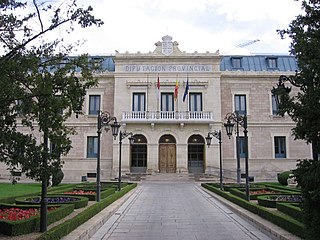
Cuenca is one of the five provinces of the autonomous community of Castilla-La Mancha. It is located in the eastern part of this autonomous community and covers 17,141 square km. It has a population of 203,841 inhabitants – the least populated of the five provinces. Its capital city is also called Cuenca.

Albacete is a province of central Spain, in the southern part of the autonomous community of Castile–La Mancha. As of 2012, Albacete had a population of 402,837 people. Its capital city, also called Albacete, is 262 kilometres (163 mi) by road southeast of Madrid.

The province of Ciudad Real is a province in the southwestern part of the autonomous community of Castile-La Mancha, Spain. It is bordered by the provinces of Cuenca, Albacete, Jaén, Córdoba, Badajoz, and Toledo. It is partly located in the old natural region of La Mancha. Its capital is Ciudad Real. It is the third largest province by area in all of Spain, after Cáceres and Badajoz. The historic comarca Campo de Calatrava is located in the center of the province.

Ciudad Real is a municipality of Spain located in the autonomous community of Castile–La Mancha, capital of the province of Ciudad Real. It is the 5th most populated municipality in the region.

La Mancha is a natural and historical region in the Spanish provinces of Albacete, Cuenca, Ciudad Real, and Toledo. It is an arid but fertile plateau that stretches from the mountains of Toledo to the western spurs of the Cuenca hills, bordered to the south by the Sierra Morena and to the north by Alcarria. The La Mancha historical comarca constitutes the southern portion of Castilla-La Mancha autonomous community and makes up most of the present-day administrative region.

Albacete is a city and municipality in the Spanish autonomous community of Castilla–La Mancha, and capital of the province of Albacete.
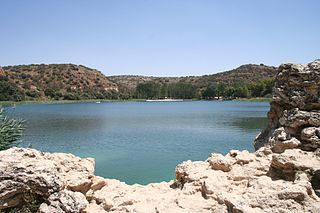
The Lagunas de Ruidera are a group of small lakes in the Campo de Montiel, Castilla-La Mancha, between Albacete Province, and Ciudad Real Province, Spain. Most of the lakes are interconnected and their total water amount may reach 23.06 hm3, which is considerable by the standards of other lakes in the Iberian Peninsula.

Alcázar de San Juan is a city and municipality of Spain located in the province of Ciudad Real, autonomous community of Castilla–La Mancha. It lies on the plain of La Mancha. From the 13th to the 19th century the history of Alcázar is strongly linked to the Grand Priory of the Order of St. John of Jerusalem. The city became a railway hub in the 19th century.

Puertollano is a municipality of Spain located in the province of Ciudad Real, Castile-La Mancha. The city has a population of 47,035 (2019). Contrasting to the largely rural character of the region, Puertollano stands out for the importance of industry, with a past linked to industrial and mining activities. It lies on the AVE high-speed train line linking Madrid and Seville.

Las Labores is a municipality in Ciudad Real, Castile-La Mancha, Spain. It has a population of 678.
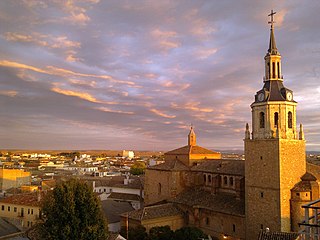
Manzanares is a municipality of Spain located in the Province of Ciudad Real, Castilla–La Mancha. It had a population of 18,924 as of 2014. It is located near the Autovía A-4.

Puerto Lápice is a municipality of Spain located in the province of Ciudad Real, Castilla–La Mancha. The municipality spans across a total area of 54.84 km2 and, as of 1 January 2020, it has a registered population of 891.
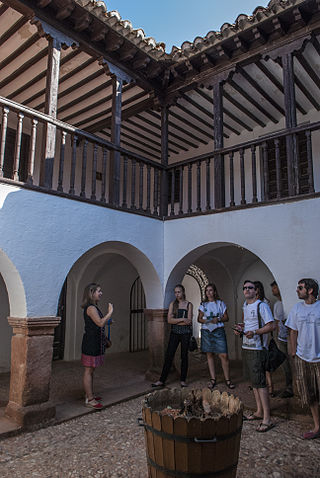
Villanueva de los Infantes is a municipality in the province of Ciudad Real, Castilla–La Mancha, Spain. It has a population of 5727 people.
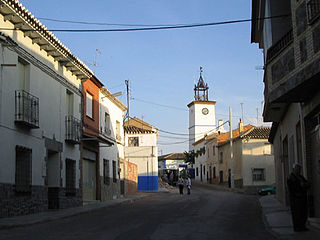
Camuñas is a municipality located in the province of Toledo, Castile-La Mancha, Spain. According to the 2018 census (INE), the municipality had a population of 1,740 inhabitants.

Consuegra is a municipality located in the province of Toledo, Castile-La Mancha, Spain. In 2018, the municipality had a population of 10,098 inhabitants. It is 80 km from Ciudad Real and 60 km from Toledo. Consuegra is located in La Mancha region, famous for its extensive dry plains, vineyards and historical constructions such as windmills.
La Garganta is a private estate, or finca, of around 15,000 hectares in extent, located in the rugged Sierra Morena, in rural Ciudad Real Province, in the region of Castile-La Mancha, Spain. It extends over lands belonging administratively to the municipalities of Almodovar del Campo and Brazatortas between the town of Conquista and the hamlet of Minas del Horcajo. Around 2003 it was bought on lease and renovated by Gerald Grosvenor, 6th Duke of Westminster. Prior to Grosvenor's acquisition, the estate was property of the Duke of Bavaria.

Ciudad Real is one of the five constituencies represented in the Cortes of Castilla–La Mancha, the regional legislature of the autonomous community of Castilla–La Mancha. The constituency currently elects eight deputies. Its boundaries correspond to those of the Spanish province of Ciudad Real. The electoral system uses the D'Hondt method and a closed-list proportional representation, with a minimum threshold of three percent.

The Campo de San Juan was the seigneurial lordship of the Order of St. John in the lands of La Mancha. It was the most important possession of the Grand Priory of the langue of Castile and León. It spanned across territory of the current Spanish provinces of Toledo and Ciudad Real. The most important urban centres were Consuegra and Alcázar de San Juan.























